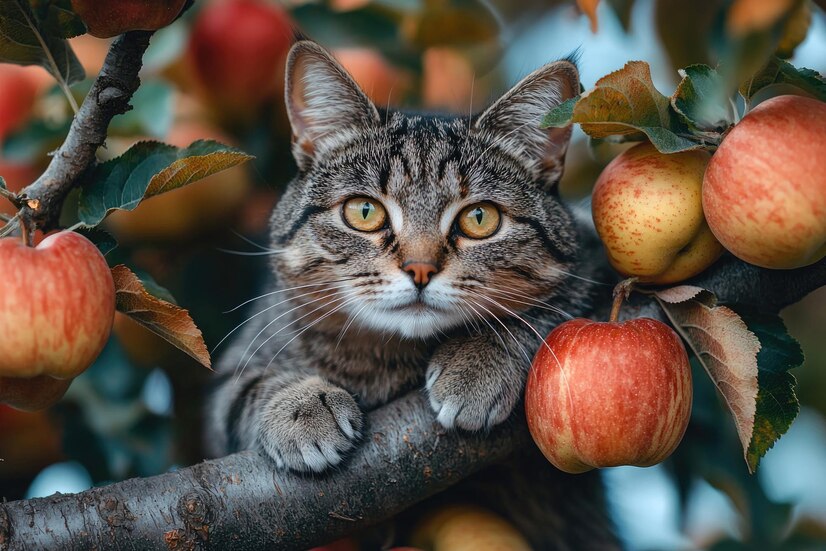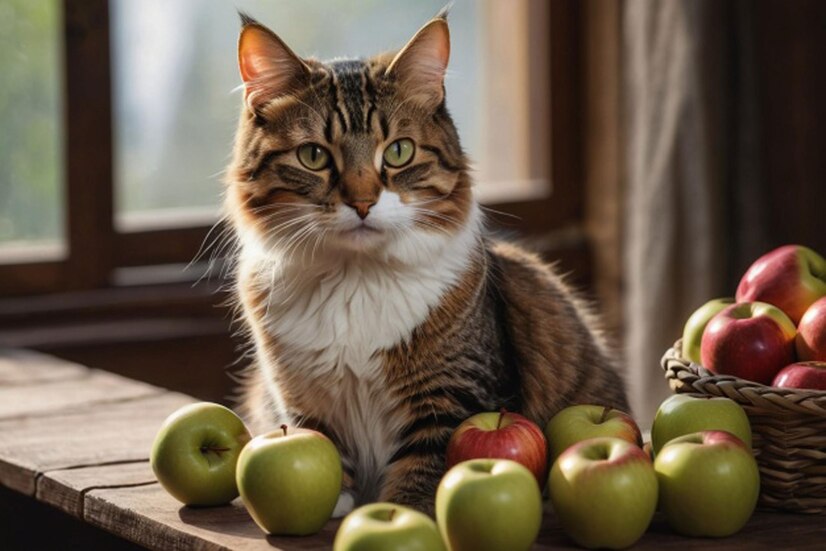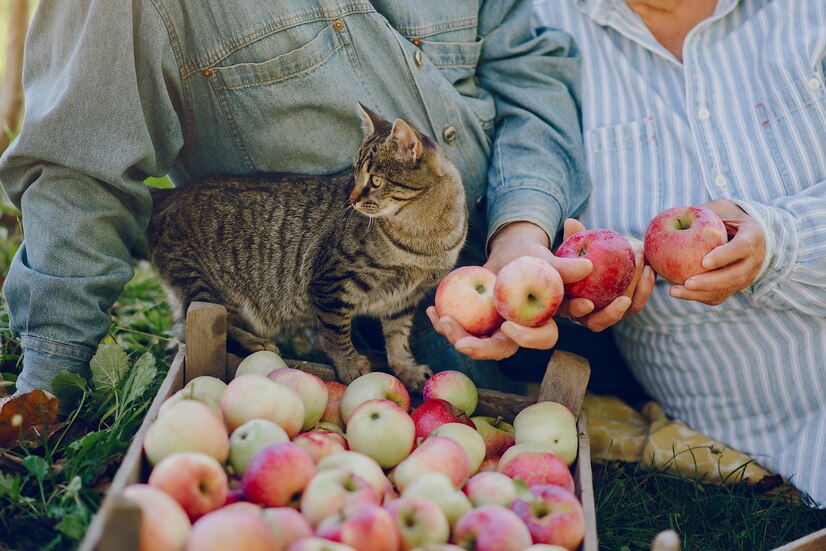Apples are a popular choice for snacks, packed with vitamins, fiber, and antioxidants that benefit humans. However, if you’re wondering whether apples are a safe treat for your feline friend, there are essential considerations before adding them to your cat’s diet. Can cats eat apples, and are they good for them? Let’s break it down with insights from veterinary experts.
Are Apples Good for Cats?
Dr. Sandra Mitchell, a 1995 graduate of the New York State College of Veterinary Medicine, notes that apples aren’t toxic to cats, but their high fiber and sugar content can cause digestive upset in some felines. For most cats, a small portion of apple is a safe, occasional treat rather than a diet staple.
Key Nutrients in Apples
Apples contain essential vitamins, including:
- Vitamin A, C, and K
- Antioxidants to reduce inflammation
- Fiber to aid digestion (though too much can cause stomach upset)
While these nutrients promote immune and heart health for humans, cats derive their vitamins primarily from meat. A few apple bites won’t harm them, but these nutrients aren’t essential for their dietary needs. Read How to Punish a cat for Pooping Outside the Litter Box

Risks of Feeding Apples to Cats
While a small amount of apple flesh is generally safe for cats, there are some important risks to keep in mind regarding certain parts of the fruit. First and foremost, the seeds, stems, and leaves pose a significant concern. Dr. Jamie Lovejoy, DVM, points out that these parts contain cyanogenic compounds that can release cyanide, which is toxic. Even though one seed might not seem like a big deal, it can become dangerous if your cat eats multiple seeds or other apple parts. Keep an eye out for symptoms of cyanide poisoning, which can include vomiting, breathing difficulties, and lethargy. So, always make sure to remove all seeds, stems, and leaves before sharing any apple with your cat. Read Why Is My Cat Laying in the Litter Box?
Another factor to consider is the high sugar content in apples. Cats don’t have taste receptors for sweetness, so they usually aren’t interested in sugary foods. However, Dr. Rhiannon Koehler, a veterinarian and freelance medical writer, explains that too much sugar can still harm your cat’s health. It can lead to weight gain, diabetes, and gastrointestinal problems. If your cat is already dealing with obesity, diabetes, or digestive sensitivities, it’s best to skip sugary treats like apples altogether.
Lastly, it’s essential to remember that cats are carnivores, and their digestive systems might not handle plant-based foods very well. They can experience digestive upset from eating too much apple or if they have a sensitive stomach. Symptoms can include gas, diarrhea, or vomiting. Read Kidney Disease in Cats: Early Signs You Shouldn’t Ignore
Signs of Cyanide Poisoning in Cats
- Excessive drooling
- Rapid breathing
- Lethargy or weakness
If your cat ingests apple seeds or other parts of the apple, contact your veterinarian immediately for guidance.
Can Cats Eat Green Apples?
Yes, cats can eat green apples, but the same safety rules apply. Green apples, such as Granny Smiths, are firmer and more sour, making them less appealing to cats. If your cat shows interest in green apples, provide a small, safe portion:
- Wash and peel the apple.
- Remove all seeds, stems, and leaves to avoid cyanide toxicity.
- Offer a small piece, such as a ¼-inch cube, once or twice a week.
Limit green apple treats to avoid any digestive upset from the high fiber and sugar. Cats often prefer more savory flavors, so don’t be surprised if they turn up their noses at a tart green apple. Read How to Stop Your Cat from Peeing Outside the Litter Box

Can Cats Eat Applesauce?
Cats should generally avoid applesauce. Store-bought applesauce often contains added sugars, preservatives, and spices that are unsuitable for cats, particularly those with health conditions like diabetes. Dr. Sandra Mitchell advises that even homemade applesauce, without added sugar or spices, should only be offered in moderation. A small lick of homemade applesauce is likely safe, but plain, fresh apple flesh is preferable. Read 9 Reasons Why Do Cats Hate Water?
Can cats eat apple pie?
Cats should not eat apple pie. While apples themselves are safe in small amounts, apple pie contains high sugar, spices like cinnamon, and crust ingredients that can upset a cat’s stomach or be harmful. It’s best to avoid giving your cat apple pie.
Can Cats Eat Cooked Apples?
Cooked apples are safe for cats if prepared without added sugar, butter, or spices. Cooking makes the apple softer, which some cats may find easier to chew and digest. Dr. Jamie Lovejoy, DVM, recommends cooling cooked apples completely before serving them to your cat, and only offering small, bite-sized pieces. Read 8 Litter Box Mistakes to Avoid
How Much Apple Can Cats Eat?
When feeding apples to cats, less is more. Cats don’t require fruit to meet their dietary needs, and too much apple could result in digestive issues. A few guidelines:
- Portion size: Offer only one or two ¼-inch cubes of apple per serving.
- Frequency: Limit to once or twice a week to minimize digestive upset.
Following these recommendations will allow your cat to safely enjoy the occasional apple without risking negative side effects.
Read Why Do Cats Kick Litter Everywhere?
How to Safely Feed Apples to Cats
To safely feed apples to your cat, start by washing and peeling the apple thoroughly to remove any pesticides or wax coatings. It’s essential to eliminate all seeds, stems, and leaves, as these parts can pose a risk of cyanide exposure. After that, cut the apple into small, bite-sized pieces—about the size of their kibble—to make it easier for your cat to chew and prevent choking.
Remember, apples should only be offered as an occasional treat. A few small bites once or twice a week is more than enough to keep your feline friend safe. Read Can a Dog Get a Cat Pregnant?
Other Fruits Safe for Cats
If your cat seems curious about other fruits, several are safe in moderation, including:
- Blueberries
- Watermelon
- Strawberries
- Bananas
- Cantaloupe
Read Further



